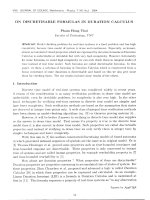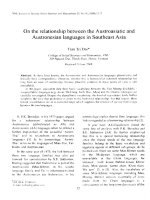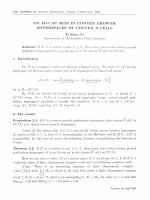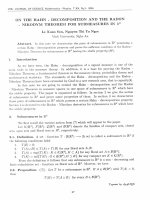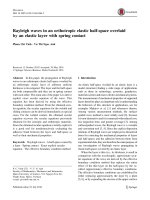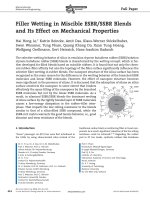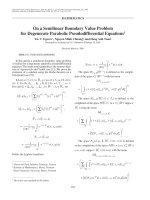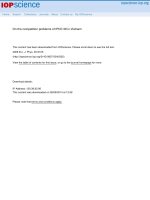DSpace at VNU: On Solvability in a Closed form of a class of singular integral equations with rotation
Bạn đang xem bản rút gọn của tài liệu. Xem và tải ngay bản đầy đủ của tài liệu tại đây (2.37 MB, 6 trang )
VNU, JOURNAL OF SCIENCE, Nat. Sci.,
t.xv,
n ° l - 1999
O N SO L V A B IL IT Y IN A C L O S E D F O R M
OF A C L A SS OF
S IN G U L A R IN T E G R A L E Q U A T IO N S W IT H R O T A T IO N
N guyen Tan H oa
Gia Lai Teacher’s tra.iiiing college
A b s t r a c t . In this paper we shall give some algebraic charactenzations of the oper
ator s „ k of the form (2) and study solvability in a closed form of singular integral
equation of the form (1).
By algebraic method we reduce the equation (1) to the system of singular inte
gral equations and then obtain all Solutions in a closed form.
Suppose t h a t r = {/ : |/| = 1},D + = {z : l^l <
= {z : |2 | > 1}, arc
respectively the boundary, interior and exterior of th e unit disk on th e com plex plan
Consider the singular integral equation of the form
where ự>{f), f { f ) , àự) Ễ H^{T)
(0 < /i < 1).
Define
( 5 „,a. ^ ) ( 0 =
—
7Ĩ /
/
^
/p
T
^
i 1: » t
/V
(2 )
‘T T
^1 == e.r.p( — ), £ị.. = e l
(U» ( 0 =
It is easy to chock th at
s w - w s.
5„.a-VV - W Sn ^-.
5„,a-S - 55„.A.
(3)
Denote
p = i ( / + S ) .< ? = ị ( / - S ) ,
=
(4)
u=\
Thon
16
O n S o lv a b ility i n a Closed F o rm of...
17
= p, Q'^ = Cl P Q = Q P = 0
(5)
P ,P ,= 6,jP,.
(6)
Ỉ — P\ + Po + ■■■ + F-2„+ . . . + e ^L ' P 2n.
i r " = 54 ÍpP , +
+ e4^P
P 22 +
(7)
A' = . Y - 0 A ' - = . 0 A ' ,
./-1
where
- ỌA'. x , - P j X
A'+ - FA ',
L e m m a 1. Let
defined
lie
HS
[j =
IS the Kronecker symbol.
in (2). Then
Sr,.k- = 5Pa- - SP„+k (Ẳ- = 0. ri - 1),
(8 )
u-iiere we p v t Pq = P-2 „.
Pr oof : Fioiii t h e i de nt it y
^ n
— [ — k ỷk-
7-n ^ fri
^ ‘2 n ~
l — kỷk-
^ n
ỵ2rt _ f ‘2n
— ì — k ỷ ĩ ì + k
^2n _ fin
■
Wo obtain
1 /■
« I' ì i - - ị ~ k ỷ k
/' ^^ \ 2n
I'
(
1
ị
Ị ~ ì - k ị ĩ ì + k
/■ ^ Ĩ n-l-A-.r)+A
ị-
- „ l
~
í
,í
= { S F , ^ ) { t ) - ( S F „ . ^ ,^ ) ịt) .
(svv
L e in n ia 2. E v e i y u p e n ì tu i .S'„,A. i.s ÍÌÍJ íìỉgelníìic opciHtui with the cỉiHiHctciintic pulynoIiiial
A'^ - À for ĩì > 1,
A'“ - 1 for it — 1.
Proof. L('t n = 1, from (3). (5), (6 ) and (8 ), we got
S l o = { S P o - S P , f = Po + P, = / ,
It is easy to check th a t Pỵ
Let
IÌ
(A) = À* - 1.
> 1 .from (3), (5) and (8 ), \VP got
= S' i , , Sn, ,
= {P, + P „ + , ) ( S P , - S P n +, )
N g u y e n Tan Hoa
= SPk - SPn +k = s„,k-.
To finish the proof it suffices to show th a t for every polynomial Q(A) = a \ ^ +
such th a t Q{Sn fc) = 0 we can follow
Q
= /3 = 7 = 0
{a, ị3,~f e C) . Indepd, from (5 vr
have
r 0 = PkQ{Sn,k) = (a + l)Pk + 0SPk,
10 = P„ +kQ{Sn,k) = (7 - a)Pr. +k - í3SPn +kFrom the last equalities, we get a = /3 = 7 = 0.
L e m m a 3. [2j I f th e function K { t J ) can be extended to
such a manner ti a t
A'(r, 0 is analytic in both variables in D+ an d is continuoiis ill D + . Then
1.
I K ( t , f)ự>{T)dt e
2
for every if ^ X \
f
I K{T,t)ip'^{T)dT = 0
for every
e
In the following, for every function a{f) € X , we shall write
Ự
Then for e v e i j k , j G { l,2 ...,2 n } the foUow:ng
identity fields
P , K a P , = K a , ^ P , = PkKa^,,
where
2n
1/= 1
Now WP deal with the equation of the form (1). Rewrite this equation as follows
^ { t) + b { i) { S P ,^ ) { f) - b(t){SP„+,ự>){f) = f {f ).
(9)
L e m m a 5. T he equation (9) is equivalent to the following system
ị (P,ự:>){t) + b { t ) { s p , ^ m - k ( t ) { s P n + k ^ m = {Pkf)(f),
< {Pn +k ^ m + ỉ>,{t){SPK-ự^){t) - b{f){SPn +, < p m = (Pn+A-/)(/),
, ^{ t) = f i t ) - b { f ) { S P ,^ ) { t ) + b{t){SPn +, ự ^ m .
where
m
=
l/= l
Proof: According to Lem m a 3, we have
= à
E l - ' ) - ' ’!"-')-
u =i
( 10)
On S o l v a b i l i t y in a Closed F o rm of...
19
I \ K , F , = K ,,, p, =
p„ t A-A),p,, u
= ỉ
ĩ^k ỉ^bỉ^tt+k- = I'^hi
ỉ^nịk- =
rifA-i
h \,,,,p , = h \p ,.
H('nc('. (9) ịs cquivalf'nt to tli(' s ystoiu
' ^{t) + h{t ){SP, ^)(f ) - b{f)ịSP„+,ip)it) = f{f).
ịỉ\-^){f) + ĩ>(t)(SP,^)Ự) - h,{f){SP„^,.^){t) = i P, f ){ f) .
.
. {P„^k-^){f) + ỉ> ịụ) {Sỉ\ự ^)(t ) ~ b i t ) ị S P „ u - ^ ) ự ) = ( p „ + A . / ) ( 0 .
Mon'ov('i , ít lias hpon prove th at tho last system is equivaleiit to ( 10). H('ncc. in onlf'r to
St)l\'c tli(’ ('C|natioii (9) it suffices to solvf' th(’ following aystf'iii
r ^, { f ) + b{t)(S'^,]it) - ĩ>ị{f)is^„+,){t) =
I
in th(> s p a c e x \
L e m m a 6.
+ /
;
,
(
0
(
5
^
J
(
0
= (P„+A-/)(0-
X x „ + f_.
li
ip„ ịj,.) is ii sohitiuii o f S y s t e m (11) in A' X A' then
P„+/.-ự!„
is ÍÌ s u h i t i u i i o f S y s t viii ( 1 1 ) i n A'/,. X
Proof S n p p o s v that
y-!„
is a soli irion o f S y s t e m (11) in A' X A'. Actin'^ t o b o t h sid e
of system ( 11) by oporatois P/,, p„
rrspertivcly. by virtue of Lf'iniiia 1. \V(‘ g('t
(Ay-aOíO + h{f){SP,yO,){t) - h A f ) { S P „ , , ^ „ , , ) { t ) = (P,VP)(/),
I ỉ^..u r „n. ) ( t ) 4 h, (t){.^P,
llciicc. (ì \ ^ị , ^.
+
j
A,tA)(/)
/,.) is a so lu tio n oi' s>-st('iu (11) in . \ \ X A'„ 4 /,.
( / ’„, . / ) ( / ) ■
□
D u e t o K'siilts ()1 L( 'nin ia 5 a n d Li 'imiia 6 \V(' o b t a i n t!i(' followiiij’ K'snlt.
L e i i i i n a 7.
I'iic cqiinliun (9) is sulvnl)!c in X i f n n d on ly if the s y s t e m (I I ) is solvỉìhlc in
A X A ^ MunH nv r. e v c i y subitivii ol (9) CHII l>c (ỉctcnninctì i>y the furiuuhi
^o(/) = / ( n _ b { t ) { S P , ^ ) ( t ) + h { t ) { s p „ , ^ , ^ ) { t ) ,
wlieiv ỷ{t ) = ( ỉ \ .ph){t) + {P,r-ị ^-‘p„..ịi,-){f ). [Ọk-- 'Pu +k) )■*>'a solution oi'systein ( I I ) ill X X X .
T h e o r e m 1. Suppose tlint (l[f)(i{T) is a continuoiis fmictiou in (r, f) e r X r which admits
fill lUUilytic pnAongHtiuii in i>uth vHiifihlcs uiitu D * , where
a{f ) = 'b{f) + b^{i), d{t) = b { t )
(12)
Then th e equ ati on (9) adiiiits Ỉìlỉ suììitioii in H closed foini.
Proof: Diu' to the rosults of Lemm a 7, it suffices to show th a t the systrai ( 11) adm its all
solution in a closod form. T he systom (11) is oquivalf'nt to the following system
N g u y e n Tan Hoa
20
I ự>kự) + Ỉ
3)
— ^ n +k:{f) + ^ ( 0 S{ipk + ¥^n+fc)(0 ] = ( A - / ) ( 0 “ {Pri+k-fi^))'
where a { f ) , d { t ) are defined by (12).
Put
V’l ( 0 = ‘P kự) +
r
+ {KaS->J’2){f) = 9 \ ự ) ,
I M ỉ ) + i KdSĩ l >i ) {t ) =92Ìf ) 4>i {t ) + { K a S r J > 2 ) W = 9 i { t ) ,
(14)
o
V.-'2(0 - [ K a S K a H W ) = 9 2 { t ) - d { t ) ( S g , ) { t ) .
In order to solve th e System (14), we have only to solve the equation
ĩj>2{t) -
KdSKaSĩJ^2
(15
[ K d S K a { ĩ l > ĩ + rj’ĩ ) ] i f ) = 5 3 ( 0 ,
(16)
where g s ự ) = g 2 { t ) - d { t ) { S g 3 ) { t ) .
Rewrite (15) as th e following
v 4 (0 -
V’2 ^ ( 0 -
where
ĩ l >ỉ { t ) =
{Pi'2)if),
= -(< 3 V '2 )(0 -(V '2
e ^
' V-2
)•
By our assum ption for ( r - f ) “ 'rf(f)a(r) , by the Lem m a 3, wc have
{ K u S K a t ỉ m = 0.
(17
v 4 (f) - { Kl SKaĩ ỉ ’ĩ ) { t ) - v V (0 = <73(0-
(18)
From (16) and (17), we get
It is easy to see th a t
ệ+{t) := ^,+ {t) - {KdSKaV>ĩ){t) e x \
ệ (f) := V’2 (0 e X
.
19
Hence, the equation (18) is just a Riem ann boun dary problem
ệ+ự)-c(>-{f)=93{t).
20
T he equation (20) has the solution
{
=
2.93 (^) + ^ { S g s ) ^ ) ,
(í>~'ự) = =Y93{f) + ụ s g 3 ) { t ) .
(21
U n S o lv a b ility i n a Closed F o r m of.,.
21
From (19) and (21), we obtain
V-2(0 =
- */V(0
= ộ ^ { t ) - ộ - ụ ) + ( KaSKaậ~) { f )
= fi3Ìf) ----- — {K,iSKag3)(t)
+
-{K\iSKaSg-.ị){f).
The thooiom is proved by a similar argunuMit as above, we prove a dual statem en t, namely
WP ha\'e
T h e o r e m 2. Suppose that (r - 1}-^ .r/(f }a(r) is n continuous fiiiictioij in ( r j ) e r x r
which Hcỉiniĩs HỈ1 analytic prolongation in i)oth variahỉes on to D ~ , where ^ ( 0 , ^ ( 0
defined by (12). Then the equation (9) adinits ail solution in H closed fonn.
A c k n o w l e d g m e n t . The au th or is greatly indo'bted to professor Nguyen Van Mail for
valuable advice an d various suggestions th a t lod to iniprovpnient of this work.
REFERENCES
1. F.D. Gakliov. Bouiidary value pvohleins, Oxford 1966 (3i‘(l Russian coniploinpiitod
and collected edition, Moscow, 1977).
2. X g . V . M a u .
Goiieralized algebraic olonionts a n d linear singu lar integral e q u a tio n
with transform ed arguineuts, W PW , Warszawa 1989.
3. X g . V . M a i i . N g . M . T u a i i . O i l s o l u t i o n s o f i n t o g r a l f q u a ti o MS w i t l i a i i a l y i i r k i ' in el a n d
rotations. Annales Polomci Maflieinatici L X l l L 3, 1996.
4. D. Pizeworska-Rolovvicz. EíỊìiations with transformed arguments, A n algebraic appioiH.ii. Aiiiriinildiii - Wai^fiWft 197.].
5. D. Pr z ('\ vo is ka -R ol ('\ vi c z . s . R()l(‘\\'icz.
l u Ị Ui ì i ÌOTÌS lĩì L i ĩ ì a i r Sj i ace.
A nistordam -
Waizawa 1968.
TAP CHI KHOA HOC ĐHQGHN. KHTN, t XV,
v 'e t í n p ỉ
g iả i
đ ư ợ c
ở
d ạ x g
- 1999
đ ó n g
c ủ a
m ọ t
l ớ p
p h ư ơ x g
t r ìn h
TÍC H PHÂN KỲ DI VỚI PFỈÉP QUAY
N guyễn T ắn H òa
Cao âầng Sìi p h ạ m CÌH Líìi
Bài báo này sẽ đồ cập đốn vài đặc tinrng đại số của toán tử 5„ A- dạng (2) và nghiên
i-thitính giải đ ư ợ c ờ dạng đóng cùa phươĩig trình tích phản kỳ dị (lạng ( 1),
Bằng p h ư ơ n g pháp (lại số sẽ đ ư a pliương trình (1) về hệ phương tiìiih tích phân
kỳ (iỊ
và sau đó th u đưực tấ t cả rác ngliiộm ờ dạng đóng.
